Ed Gorman's Blog, page 125
June 24, 2013
RIP Richard Matheson 1926 - 2013
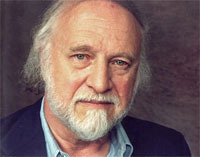
RIP Richard Matheson 1926 - 2013From Shock:
Author Richard Matheson has passed away at the age of 87. As this is breaking news, there are not a whole lot of details we can offer at this time, we'll update this spot as more information comes in but Matheson's daughter, Ali, wrote the following:"My beloved father passed away yesterday at home surrounded by the people and things he loved...he was funny, brilliant, loving, generous, kind, creative, and the most wonderful father ever...I miss you and love you forever Pop and I know you are now happy and healthy in a beautiful place full of love and joy you always knew was there..."Update: Mr. Matheson passed yesterday and sources tell us he had been ill for a bit now
.That came via author John Shirley's Facebook page and Twitter.Matheson, of course, has made a monumental impact on our genre with his works like "I Am Legend" (which spawned The Last Man on Earth, The Omega Man and I Am Legend with Will Smith and inspired Night of the Living Dead) and "Hell House" (a diving board for so many cinematic haunted house offerings as well as the adaptation The Legend of Hell House).He also penned "What Dreams May Come," many Twilight Zone episodes (one of which paved the way for Real Steel), The Devil Rides Out, Duel, The Night Stalker and so much more.He will be greatly missed...
Published on June 24, 2013 17:45
Peter Rabe Psychologist
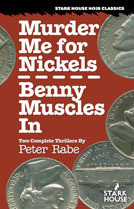
Excerpted from The Minds of Peter Rabe By Rick Ollerman
SEE STARK HOUSE PRESS FOR THIS AND MANY FINE PETER RABE NOVELS
In the same interview with George Tuttle Rabe also states that despite his background in psychology, it has not influenced his fiction “in the least.” Rabe explains that both his fiction and his interest in psychology are independent and merely stem from the “same kind of orientation and interest.”
The fascinating part of this statement is simply that it is natural for any reader of Rabe’s work with knowledge of his background to ask precisely that question, as did George Tuttle. This is because Rabe’s work is so character driven, and his characters are so flawed, that their psyches, their psychoses and neuroses and thought processes, all dictate the plots of his novels.
In other words, Rabe’s characters don’t have mental quirks or attitudes that are used as devices to move the plot along; rather his characters’ very natures are what dictate the plot. This exact quality distinguishes Rabe’s work from most of his contemporaries, many of whom used flaws of this type in much more superficial ways.
For these other writers in the paperback original world, psychological elements were more a part of the general themes of their work. Raymond Chandler’s Philip Marlowe must be noble above all else, or as he said in his essay “The Simple Art of Murder,” “He must be the best man of his world and good enough for any world. I do not care much about his private life […]” Marlowe has the code Chandler has given him, and this code guides Marlowe throughout his stories. Indeed, as Chandler has said, he doesn’t care much about Marlowe’s life beyond that.
James M. Cain’s or David Goodis’s protagonists are in more of a psychological rut: they have no intent to cause the bad things they do, rather they fall into them with eyes wides open, powerless to stop themselves or alter events in any meaningful way. It’s never clear whether they’d even want to if given the choice. For the sake of the story, they simply must march on.
Jim Thompson wrote about some clearly psychologically damaged specimens, starkly so, prototypical sociopaths and psychopaths, served up for mass consumption. When we know from the start the protagonist has certain psychological issues, we know how he will act throughout the book. The question may be in how far he will take things, or in what manner he will betray himself or be caught, but psychological elements infuse the entire narrative.
Rabe’s method of using psychological attributes is far more subtle. His best protagonists are neither completely sane nor completely crazy, all good or pure evil, right or wrong, noble or ignoble. They’re quite often a blend, a combination of contradictions, made up of psyches not quite working wholly together.
Like James Quinn from The Box, a mob lawyer intent on splitting the organization he works for in half, siphoning power away from the incumbent Ryder. Only Ryder won’t take this sitting down and cares nothing for the precautions Quinn has made should something happen to him. Ryder makes it happen anyway. His men dope Quinn, seal him in a crate, and send him on a trip around the world via the hold of a cargo ship. Only Quinn is discovered early, in the African port of Okar, before he experiences the full level of despair, or even death, that Ryder intended. It’s clear to the Westerner who takes charge of Quinn what has happened to him but when he seeks confirmation of Quinn’s criminal past, Quinn merely tells him he has no record.
Quinn thought that with no record he was either a very good criminal or no criminal at all, and perhaps it came to the same thing. He had not been very much interested in deciding on this because other things meant more to him. Whether he had been smart or stupid, for example, and here the decision was simple. He had been very stupid with Ryder, but that, too, was a little bit dim, since he, Quinn, was here and Ryder was not. Maybe later, more on this later, but now first things first.
So Quinn gives some thought to what had happened that got him shipped halfway around the world by his arch enemy, but surprisingly not much. Instead he sets about finding out who runs the local black market and immediately makes plans to take it over. A lone man, with no money, friends or resources, only a compulsion not justified or explained to the reader, only made felt by the author, is absolutely driven to take over in Okar what he couldn’t back in the States. We don’t know what happened to make Quinn this way. We wonder at his audacity, his self belief, and above all what could possibly make a man, any man, act this way. For Quinn it’s an inevitability; for Rabe it’s another subtly nuanced “non-normal” protagonist. Quinn is just different.
Published on June 24, 2013 09:13
June 23, 2013
A Few Fun Facts about Mamie Van Doren


Ed here: Mamie Van Doren was the Queen B of B pictures during the late 50s and early 60s.
She was much more talented than the other sexpots and a lot more fun to listen to interviews. She was smart and outspoken. I watched two of her movies on TCM Friday night. she was even sexier than I remember but there was a womanly intelligence in her persona, too. At moments she could be vulnerable and even...no kidding...maternal. She was at her best in all the juvenile delinquent movies. Sure most of them were lousy but she was great.
Here's from TCM last Friday:
When Mamie Van Doren was just 17-years-old she spotted an advertisement in Variety posted by pin-up artist Alberto Vargas who was looking for new models. Mamie responded to the ad and Vargas hired her to model for a new Esquire calendar he was working on. A few years later when Vargas was showcasing his work at the Shrine Auditorium in Los Angeles, Vargas asked Mamie to appear there with him to help promote the show. Mamie is an animal rights activist and she currently takes care of a number of adopted dogs and birds. In a recent interview with Donald D’Haene at The Good Man Project she explained why supporting animal rights is important to her: “Animal rights were not on anyone’s agenda when I was growing up on the farm in Rowena (South Dakota). Animals were for working and eating. I was a lonely kid whose only friends were animals, so as you can imagine, I suffered with them. That stays with me today, making me an advocate for animal rights.” While performing on Broadway as a chorus girl in a production of Billion Dollar Baby, Mamie dated the World Champion boxer, Jack Dempsey. The couple could often be seen together sharing drinks at the Stork Club and Dempsey eventually proposed to her. But Mamie had other plans and she ended her relationship with Dempsey after moving back to Hollywood to focus on her acting career.Mamie Van Doren was originally born with the name Joan Olander. She was named after actress Joan Crawford and the two women eventually crossed paths in Hollywood. Crawford once said of Mamie and fellow blonde bombshell Jayne Mansfield, “They aren’t even actresses. Those are boobs with mouths trying to get publicity.” But when asked which of the three M’s (Monroe, Mansfield or Mamie) she preferred, Joan Crawford claimed to prefer Mamie. The buxom actress has posed for Playboymagazine a few times beginning in 1964 to help promote the movie, THREE NUTS IN A SEARCH OF A BOLT. This silly adult sex comedy was the last film directed by the actor, writer and producer Tommy Noonan who died a few years after production. Mamie still attends parties at the Playboy mansion and is friendly with publisher Hugh Hefner.During the Vietnam War, Mamie entertained US troops in some of the most dangerous battle zones. Her shows were hugely popular and attracted large crowds. Mamie was deeply touched by the scenes of violence she witnessed and the various encounters she had with young soldiers. She has said that, “Nothing could have prepared me for the horrors of war. By the time I left Vietnam, the things I had seen and heard left me changed forever.” The experience seems to have made Mamie reconsider her political leanings and outlook towards war.
Acting isn’t Mamie Van Doren’s only talent. She’s also released a number of albums. Her earliest record was a collection of songs from the Warner Brothers film, UNTAMED YOUTH. The songs were written by composer Les Baxter and the legendary guitarist Eddie Cochran played on most of the tracks. The record was released in 1957 by Prep Records, which was a subsidiary of Capitol Records and Mamie Van Doren was the first artist they signed. Her latest album is a collection of country & western flavored songs titled Still a Troublemaker.
Published on June 23, 2013 12:26
June 22, 2013
Top Suspense Sizzling Summer Sale $1.99 per title


Edgar Award-nominated author's classic novel of Texas politics and murder, available for the first time in e-book format! Political intrigue, romance, and humor with a Texas twang.
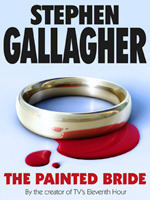
From the author of THE BEDLAM DETECTIVE and screenwriter on various BBC TV series comes a suspense novel with Molly Gideon, a young recovering junkie who must avenge her sister's killing.

From the bestselling author of The Walk, The Heist (with Janet Evanovich) and Adrian Monk mysteries is this wild, rollicking, action-adventure novella featuring Los Angeles cop John "Tidal Wave" McGrave.
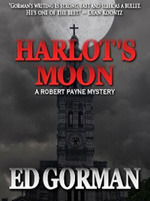
From an award-winning master storyteller, ex-FBI profiler Robert Payne must find the killer of a Catholic priest who had been hoarding newspaper stories about two other brutal murders.
.
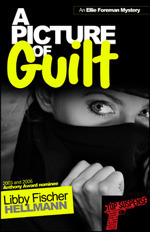
A cross between "Desperate Housewives" and "24," Chicago videographer Ellie Foreman unwittingly gets involved in the murder trial of Johnny Santoro, a dock worker whose girlfriend has been killed. Award-winning series.

Described by Michael Connelly as "a private ticket into a secret world of desire and sex and the raw edge between them," this Edgar Award finalist is noir at its best: playful South Beach sex leads to body parts sent into the Everglades.
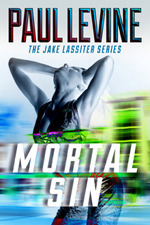
In this thriller which "recalls the world of Carl Hiaasen" with "a smashing climax," linebacker-turned-lawyer Jake Lassiter defends a mob-connected millionaire in Florida court while also bedding his wife.

From the Stoker Award-nominated writer of dark tales, ex-Ops teammates reunite to stage one last mission against a mysterious cult with plans to unleash a deadly virus.

In the latest novella in the award-winning Julius Katz mystery series, Archie, the great detective's digital sidekick, must solve the case of a murdered chef. Four other notable stories included.
Published on June 22, 2013 12:56
June 21, 2013
NO EASY ANSWERS by Carolyn Hart

No Easy Answers is another first-rate early Carolyn Hart novel from the fine folks at the Oconee Spirit Press.
For my generation there was no more bitter a historical time than the years of the Viet Nam war after 1965. For the majority of people you were for or against. There were excesses on both sides. The anti-war people burned the ROTC building in Iowa City while I lived there. The Chicago cops turned demonstrations into blood baths. If you were anti you were a Commie and if you were pro you were a war monger. Vice President Agnew, in between taking bribes in the VP's office, decreed that some protestors should be deported.
Carolyn Hart did the impossible, wrote a riveting domestic espionage novel set in America during these angry years--and let both sides have their say.
Draft-age Bart Hastings, who has begun to doubt the necessity of the war, must help his father, a military man after the Colonel who is suddenly and suspiciously accused ,selling secrets to the enemy. Hart's skills are all on display here. As these early novels prove she has a great affection for spy and espionage fiction. False leads, cliff hangers, shadowy figures, Hart keeps you turning pages while reflecting soberly but unobtrusively on the war itself.
I read this in two quick sittings and enjoyedy every word of it.
Published on June 21, 2013 15:18
June 20, 2013
Forgotten Books: Death's Sweet Song by Clifton Adams
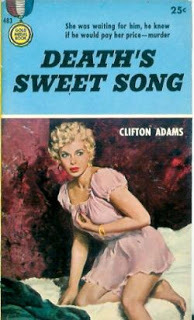
"It was in the streets of Palamera that Gunner Flagg lost interest in bank robbing as a profession."
Clifton Adams was a jazz musician who wrote westerns of a high order in the Fifties and Sixties. Donald Westlake has talked about how much he admired Adams' The Desperado when it first appeared from Gold Medal back in the Fifties. And numerous other writers of both crime and western have talked about his influence on them.
I like Adams because his bad guys have always struck me as real card-carrying members of the criminal class. They aren't mythic. They just want money or sex and power. When you read James Reasoner's fine Draw: The Greatest Gunfighters of The American West you soon see what a joke the mythic west is. The criminal class, whether high or low, has always been the same in just about every historical context. I'm sure that street gangs controlled parts of ancient Rome and we have only to look at early New Orleans and Boston to see that various forms of gunfighters roamed the streets and killed a whole lot of peope.
Adams wrote a lot of books and as result some were better than others. I'm partial to A Partnership With Death. I once said that David Goodis didn't write novels, he wrote suicide notes. I could say the same about Partnership. Another, Hot Town, is a Hammett-like noir that could have appeared in the early years of Black Mask when they ran hardboiled westerns. One hard mutha of a narrator telling one mutha of a tale of crooked politcians in the old west. You have only to look at the oil indstry today to see that this bunch is still doing well. The Most Dangerous Profession is a western crime story about a drifter signing on to guide four easterners on a hunting trip. Good grim stuff.
He wrote, that I've been able to figure out, four Gold Medal crime novels and all of them are excellent. Vintage Hardboiled Reads reviewed Death's Sweet Song awhile back and had this to say:
"Joe Hooper owns a fled-bag motel in Oklahoma and is about to go under. Along pulls up Karl Sheldon, with his beautiful young wife Paula. Hooper is desperate for extra cash and Shelden, with sexy Paula's help, wheels him into a payroll robbery. Things go wrong, deadly wrong....
"This may be the best crime fiction novel that Gold Medal published in the 50s. It's a story of how things can spiral out of control once you take that step-and you can't go back. Joe Hooper is a character the reader cares for, even as he goes bad. You feel the weight and burden he carries, which slowly drags him deeper and deeper until the end; where he decides his own fate. Adams builds on the relationship between Hopper and his father in the story. Hooper struggles knowing he is disappointing his father through his actions and this compounds his inner torment. Hooper sweats it out throughout the novel and we are right there with him.
"Strong characters, nicely paced and well told. Definitely noir-fiction. Robbery-Cheating-Murder-This one slams into you."
He also wrote a pair of Ace crime novels as Johnathan Gant (paired with other writers in Double Book form) and at least one soft core novel.
Like most writers, he had at least one obsession and in his case it was the relationship between fathers and sons. On several occasions he had the ability to hurt you with his observations on that theme.
posted by Ed Gorman @ 1:38 PM
Published on June 20, 2013 14:52
June 19, 2013
New Books: Troy D. Smith Cross Road Blues
[image error]
I first got the idea for Cross Road Blues and its hero, Roy Carpenter, a few years ago when I took an African American literature class and wrote a paper about “Blues Detectives,” thereby delving more deeply into the works of authors like Chester Himes and Walter Mosley. I had wanted for some time to branch out in my own writing and do some good old-fashioned hard-boiled stuff. That, plus my love for the blues, led me to the idea of a series set in 1950s Nashville that centered on a frustrated harmonica player who moonlights –or maybe daylights –as a private detective. I saw it as a way to have some noir action, some philosophizing about the meaning of life and the blues, all while taking Roy through the turbulent events of the 1950s (and eventually 1960s) in the South.The plot revolves around Roy becoming caught up with a sleazy manager and a (very) eccentric guitarist, who get him involved in a scheme that results in him being framed for murder and pursued by both the police and local drug dealers.I was fortunate enough to be taken on by John Boland’s Perfect Crime Books, an imprint that also features several of my personal favorite crime writers. Authors who know their business have had really nice things to say about the book:
"CROSS ROAD BLUES isn't just one of the best crime novels I've read recently, it's one of the best crime novels I've read in a long time... You need to read this one, and I recommend it very highly." -James Reasoner“If Robert Johnson made a deal with the Devil at the crossroads, then Troy Smith must have made a deal with the ghost of Robert Johnson. He delivers a story told with the power and passion of the great Blues Man himself.” -Robert J. Randisi“Troy Smith’s got his mojo workin’ in this fast-moving, atmospheric crime novel set in the blues joints and back alleys of the 1950s.” -Bill Crider
I’ve followed the novel up with an ebook short, “Stomp Boogie,” in which Roy is hired to track down a missing maid. I’m not sure if I’m going to do several more of those or move into another full length novel –but I do have plans to use an older version of Roy Carpenter in my ongoing series of hardboiled short stories, “Dead Rednecks,” set in modern-day Knoxville.
Published on June 19, 2013 14:07
June 18, 2013
James Reasoner

Ed here: I was always a fan of Mike Shayne Mystery Magazine. I still remember when it first appeared in the late Fifties. Cool covers and name writers. Little did I know that a decade or so later people like Bill Pronzini and James Reasoner would be writing the "Mike Shayne" short novels that appeared in each issue. In fact James wrote all of them for a number of years.
"The Man in The Moon" is a first rate private eye story--you wanna know how to write one? outline this--starring a p.i. James did a number of stories about in Shayne. At Kindle 99 cents it's the equivalent on a nice big very cold ice cream cone on a hot summer's day. Very nice work.
Here's an excerpt from an interview with James from Storyteller's. Fascinating.
StoryTeller’s 7 1. I downloaded a novel the other day called TEXAS WIND, your debut novel, published in 1980. I’ve read that it’s considered one of the finest private eye novels ever written. Quite an achievement for a first novel. What kind of pressure did that put on you?
JR: I don’t think it really put any pressure on me because it took a number of years for the book to develop that reputation. When the book came out it got very little distribution because the publisher was about to collapse (I didn’t know that was going to happen when I sold the book to them). So, for a long time it was just an obscure first novel that became something of a cult item because the few people who read it kept beating the drum for it. And while that was going on, I kept writing other things, so I didn’t really look back. Now, of course, I’m very pleased and gratified by the response TEXAS WIND has gotten over the past 33 years since it came out. I was so young when I wrote it that anything good in it is just pure instinct on my part. I didn’t really know what I was doing. (Most days I still feel like that.)
2. You’ve written over 200 novels in a broad range of genres and under numerous pen names. If you were asked to name your top three favorite novels which ones would they be and why?
Actually, I’m closing in quickly on my 300th novel. The one I’m working on now is #298. But as for my favorites, in no particular order: UNDER OUTLAW FLAGS, my Western/World War I novel, for a couple of reasons—I really like the narrator’s voice in that one and think I hit most of the notes I was trying to hit, and also because I wrote myself into it as a character (I’m the fat little kid eating popsicles and reading comic books in the framing sequence). - See more at: http://www.tomrizzo.com/storytellers-...
Published on June 18, 2013 12:24
June 17, 2013
The Face by Ed Gorman
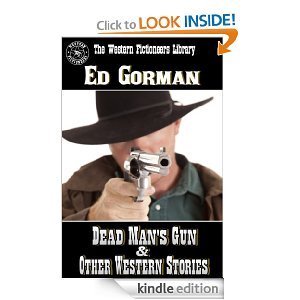
 ROC, 1995 Edition
ROC, 1995 EditionFrom Gravetapping by Ben Boulden http://gravetapping.blogspot.com/ "The Face" by Ed Gorman Ed Gorman is one of the most undervalued writers of his generation. His work, at its best, is seemingly simple, but has a subtlety and power rarely approached in genre fiction, and his characters tend to the real rather than the flamboyant and over the top. Mr Gorman’s 1990 story “The Face” won a Spur Award for best short story, and it truly deserved the honor.
“The Face” is a Civil War story. It is a first person narrative of a young Confederate doctor who can see the end of the war, and the true situation of the decaying Confederacy—
“ As a young doctor, I knew even better than our leaders just how hopeless our war had become. The public knew General Lee had been forced to cross the Potomac with ten thousand men who lacked shoes, hats and who at night had to sleep on the ground without blankets. But I knew—in the first six months in this post—that our men suffered from influenza, diphtheria, smallpox, yellow fever and even cholera; ravages from which they would never recover; ravages more costly than bullets and the advancing armies of the Yankees. ”The Confederate army is disintegrating from the costly war, and its men—in fact mostly young boys of 13 or 14—are beginning to desert. The narrator’s camp is different; none of the men have yet to desert, and its preparations for war continue. This changes when a single soldier is brought into camp. He has no visible wounds, but he is comatose with a disconcerting look on his face. When he is brought into camp the commanding general physically flinches at the sight of his face and immediately puts him in quarantine.
The soldiers face is never completely described in the story beyond the camp’s priest’s description—
“ It’s God’s face. I had a dream last night. The man’s face shows God’s displeasure with the war. ”The men of the camp sneak into the tent to look at the face, and each sees the horror of the war, specifically the horror of his own war, on the soldier’s face. The men begin to desert, and even sabotage the camp. The doctor, whose name we never learn, also begins to dream about the battlefields he has witnessed and worked.
 Leisure, 2004 Edition“The Face” is a difficult story to categorize. It is certainly an historical story, which captures the ugliness of war as well as any narrative I have read, but it is also something akin to straight up horror—its soft edged, almost dream like setting, creates an atmosphere of the purely gothic. It is also reminiscent of a superior episode of
The Twilight Zone
, but it is also as much a piece of literature as anything currently being written and published.
Leisure, 2004 Edition“The Face” is a difficult story to categorize. It is certainly an historical story, which captures the ugliness of war as well as any narrative I have read, but it is also something akin to straight up horror—its soft edged, almost dream like setting, creates an atmosphere of the purely gothic. It is also reminiscent of a superior episode of
The Twilight Zone
, but it is also as much a piece of literature as anything currently being written and published.
“The Face” is a story that will survive the ages. In a brief note included in The Moving Coffin collection, Mr Gorman explains, “The Face” was inspired by a Civil War surgeon’s journal, and it has been reprinted more than any other of his stories. It will surely continue to be anthologized long in the future because it is truly one of the best short stories written in the past twenty years; genre or literary. “The Face” was originally published in the 1990 anthology Confederacy of the Dead edited by Richard Gilliam, Martin H. Greenberg, and Edward E. Kramer. It has been reprinted numerous times in both anthologies and author specific collections, including The Moving Coffin (PS Publishing, 2007), and The Long Ride Back (Leisure Books, 2004). It is currently available in an eBook collection titled Dead Man’s Gun & Other Western Stories (The Western Fictioneers, 2013).
Published on June 17, 2013 10:56
June 16, 2013
Th Kidnapper by Robert Bloch
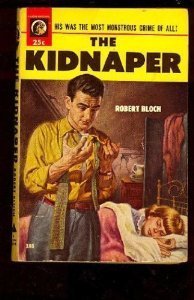
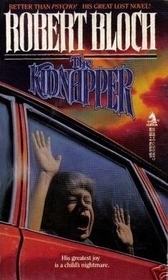
THURSDAY, MAY 15, 2008The Kidnapper
A few times a week Keith Olbermann runs stories about Dumb Criminals. Ignorant and/or Stupid people doing stupid things. The stories never involve anybody being killed.
In a certain way the narrator of The Postman Rings Twice has always struck me as deserving of a slot on the Olbermann show. Of course he went a little beyond being stupid. He killed somebody.
What Bloch has done is write a journal authored by one of these people, in this case an arrogant murderous drifter who constantly calls attention to his own supposed genius. He latches on to a nineteen-year-old maid who falls so blindly in love with him that she reulctantly agrees to help him kidnap her charge, the four-year-old daughter of a very decent wealthy couple.
The book worked on me in two serious ways. It made me examine my own class anger, number one. The slickie who tells this story believes that he has the right to hurt anyone who has more than he does. Two or three times he makes a passionate case for this. I remembered that in the sixties when an ROTC building was torched by demonstrators in Iowa City how sickened I was by the jubiliation the street. Rich or poor doesn't make any difference. Pigs is pigs. I grew up in a union family and generally agreed that American workers were exploited (if only we could have seen then just how exploited they would be a few decades later). But as always there were a few guys who had to push too far, never understanding that they were in the process of becoming very much like their enemy and the rent-a-cops who bullied them on the picket lines.
Number two is the realism of its setting, especially the first act which involves the narrator working in a factory and heading out for taverns after work. Bloch gets it down just right, a slice of Brit Kitchen Sink drama (Sunday Night and Sunday Morning told but told by a sociopathic murderer) before the Brits caught on to it.
The plot goes over the top a few times, yes, but somehow that only enhances the delusionary tone of the killer. He is a superior being therefore his entire life is over the top. No mere mortal can claim that.
I see so many crime stories on the tube that push me to wishing I was in favor of capital punishment. Some asshole marches six employees into the back of a supermarket and kills them for less than a grand? Or a wife and her tattoo sleazy boyfriend murder her husband for twenty grand's worth of insurance? Or a suburban Chicago cops kills (allegedly of course) two maybe three wives and peddles his ass on every show that will have him, grinning ghoul every time out?
Somehow all these rotten bastards are in this memoir of a really terrifying guy. No serial killer antics. No booga-bogga. Just hard core pure one hundred per cent evil.
And that's just what Robert Bloch got down in this masterful little novel.
posted by Ed Gorman
Published on June 16, 2013 12:36
Ed Gorman's Blog
- Ed Gorman's profile
- 118 followers
Ed Gorman isn't a Goodreads Author
(yet),
but they
do have a blog,
so here are some recent posts imported from
their feed.



